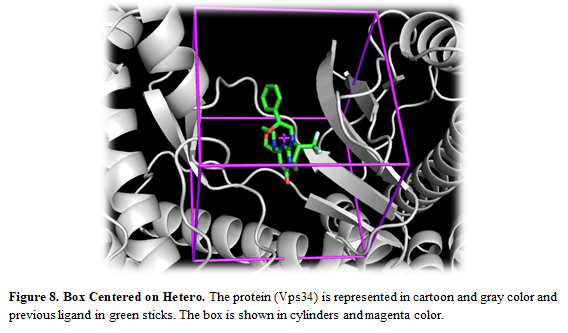4.2.2.1 re Docking experiment - Valdes-Tresanco-MS/AMDock-win GitHub Wiki
This procedure is widely used for testing how accurately certain docking engine can predict the correct structure of a given complex of interest. In this case, we chose as a study case the lipid kinase Vps34 involved in vesicle trafficking and autophagy (PDB ID: 4UWH). In a standard re-docking experiment, the ligand coordinates should be extracted from the complex and randomized.
Receptor (4uwh.pdb) and ligand (ligand.pdb) files are available at Installation_path/Doc/Tutorials/I_Simple_Docking/Box_Hetero/2.1.re-Docking folder. The crystal structure of the complex (complex.pdb) is available as well for comparison purposes.
- Open AMDock program or just create a new project if you are at “Results Analysis” tab
- Select Autodock Vina
- Set the Project Name (default Docking_Project)
- Set the Location for Project and push the button “Create Project”
- Check that “Simple Docking” checkbox is selected (It is checked by default)
- Choose the receptor file(Installation_path/Doc/Tutorials/I_Simple_Docking/Box_Hetero/2.1.re-Docking/4uwh.pdb)
- Choose the ligand file (Installation_path/Doc/Tutorials/I_Simple_Docking/ Box_Hetero/2.1.re-Docking/ligand.pdb)
Before going to the next step, go to the configuration tab and check “Ligand Protonation” with OpenBabel
- Press the “Prepare Input” button
- Then, for defining a search space, pick “Center on Hetero” and select the ligand “A:JXM:1876”
- Press “Define Search Space” button
Once the search space is defined, you can see the box in the receptor by pressing the button “Show in PyMOL”

Note: If you want to modify the box, you can use the AMDdock plugin in PyMOL. More details about this procedure here.
- Press the “Run” button
- When docking run ends, the “Results Analysis” tab will appear automatically. There, you will observe a summarizing table with Binding Energies, Estimated Ki values, and Ligand Efficiencies.
The number of poses and energies can vary since this is docking engine dependent.
- In the results table, just the first pose is selected. Press the button “Show in PyMOL” in the bottom left corner to visualize the complex.
If you want to see all the predicted poses, just select all the poses in the result table and press “Show in PyMOL”
- The crystal structure can be superposed on the predicted structure. Press “Open” in the upper left corner in PyMOL and find the X-ray structure (Installation_path/Doc/Tutorials/I_Simple_Docking/Box_Hetero/2.1.re-Docking/complex.pdb)

- A detailed report of the entire process can be seen on the right side of the screen, which allows for tracking all the results from different programs and algorithms. This log file can be saved in case an error occurred and sent to the developers.